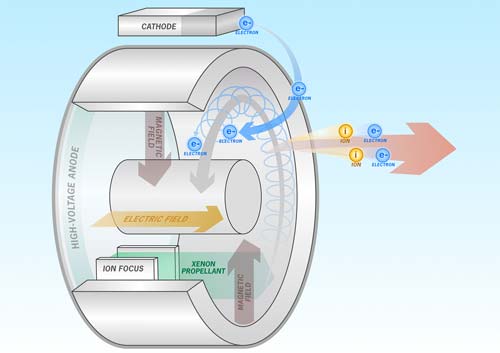The new engine helps the satellite launch into orbit with less fuel
The Georgia Institute of Technology scientists have developed a first engine capable of allowing satellites to emit from the ground with a smaller amount of fuel, opening a new door for large space projects, with lower launch costs and more payload launches into orbit.
This productivity satellite engine uses 40% less fuel by operating on solar energy while flying in space and by adjusting the speed of gas withdrawal. Georgia Institute of Technology's engine-based satellites to launch into the air are capable of carrying more payloads, thanks to the amount of fuel needed to lift the volume in flight into orbit. Or, if an engineer wants to use the reduced amount of fuel, he can launch the satellite in a cheaper way, using a smaller launcher.
Fuel efficiency improvements can also give satellites more features, such as the ability to adjust when in orbit or the ability to act as a refueling vehicle or one. trailers
The Georgia Tech Institute project, led by associate professor Dr. Mitchell Walker Daniel Guggenheim School of Space Technology, was funded by the US Air Force. The project team made significant experimental changes to one of the five engines provided by Pratt & Whitney aircraft engine manufacturer to create this finished engine.

The Georgia Tech Institute's new engine uses a new magnetic and electric field model,
has the ability to help control the air-drawing particles better. The control station is below ground
It is possible to implement this remote control institute to conserve fuel. (Photo: Georgia Tech)
Dr. Walker said the method for improving these engines is the ability to look optimally at the use of available energy, similar to a car transmission box . A traditional chemical rocket engine (attached to a satellite, this satellite is ready to launch into space) operates at maximum air discharge rate until it flies into orbit, or speaking Another way is to operate at number one
The Georgia Institute of Technology's new engine allows ground control stations to adjust the engine's operating numbers based on the direct thrust of the satellite. The engine operates at number one to increase the acceleration to the maximum during the launch into orbit, then switch to number 5, once it reaches the desired trajectory. This allows the engine to only burn energy at full capacity during key periods and thereby preserve fuel.
'You can adjust the speed of gas withdrawal to adapt to what you need from the ground,' said Dr. Walker.
Georgia Institute of Technology's new engine operates with a high-yielding ion-push system . Xenon atoms (inert gas) are introduced into the discharge chamber. These atoms are ionized, (electrons slide off the outer layer), forming xenon ions. Light electrons are bound together by a magnetic field while heavy ions increase the velocity by the electric field, thereby making the satellite high speed.
Dr. Walker said the Georgia Institute of Technology's significant improvement in the current xenon propulsion system is the new magnetic and electric field model, which helps control the gas-drawing particles better. Control stations are underground, so this remote control can be implemented to conserve fuel.
The engine for this satellite is almost ready for military applications, but it may take several years after it is put to commercial use.

Dr. Mitchell Walker, associate professor of Daniel Guggenheim Space Engineering School,
checking engine (Photo: Georgia Tech)
Thanh Van
According to Georgia Institute of Technology, Dong Nai Department of Science and Technology
- Russia helps Thailand launch a third satellite
- China's first coastal satellite launch pad
- New fuel helps rocket-friendly environment
- America put satellite reconnaissance on orbit
- Iran is preparing to launch 2 homemade satellites into orbit
- Close up of Vinasat-2 satellite on launch pad
- India and Venezuela launched satellites into orbit
- Vietnam backs up time to launch VNREDSat-1 satellite
- Launch two satellites with a rocket
- Arianespace launched the first satellite of Vietnam
- Russia is about to launch its first private satellite
- Korea launched the first satellite into space
 Daily use inventions come from universities
Daily use inventions come from universities Special weight loss device helps prevent appetite
Special weight loss device helps prevent appetite 8 inventors were killed by their own inventions
8 inventors were killed by their own inventions Iran invented a motor car powered by water
Iran invented a motor car powered by water China has successfully built the first quantum engine using quantum entanglement.
China has successfully built the first quantum engine using quantum entanglement.  Japan experiences problems during Epsilon S rocket engine test
Japan experiences problems during Epsilon S rocket engine test  Supersonic drone with speed up to 6,174km/h
Supersonic drone with speed up to 6,174km/h  Rotary engines help aircraft reach supersonic speeds
Rotary engines help aircraft reach supersonic speeds  Engine helps the plane reach Mach 6 speed
Engine helps the plane reach Mach 6 speed  Why does a car engine vibrate when starting?
Why does a car engine vibrate when starting? 